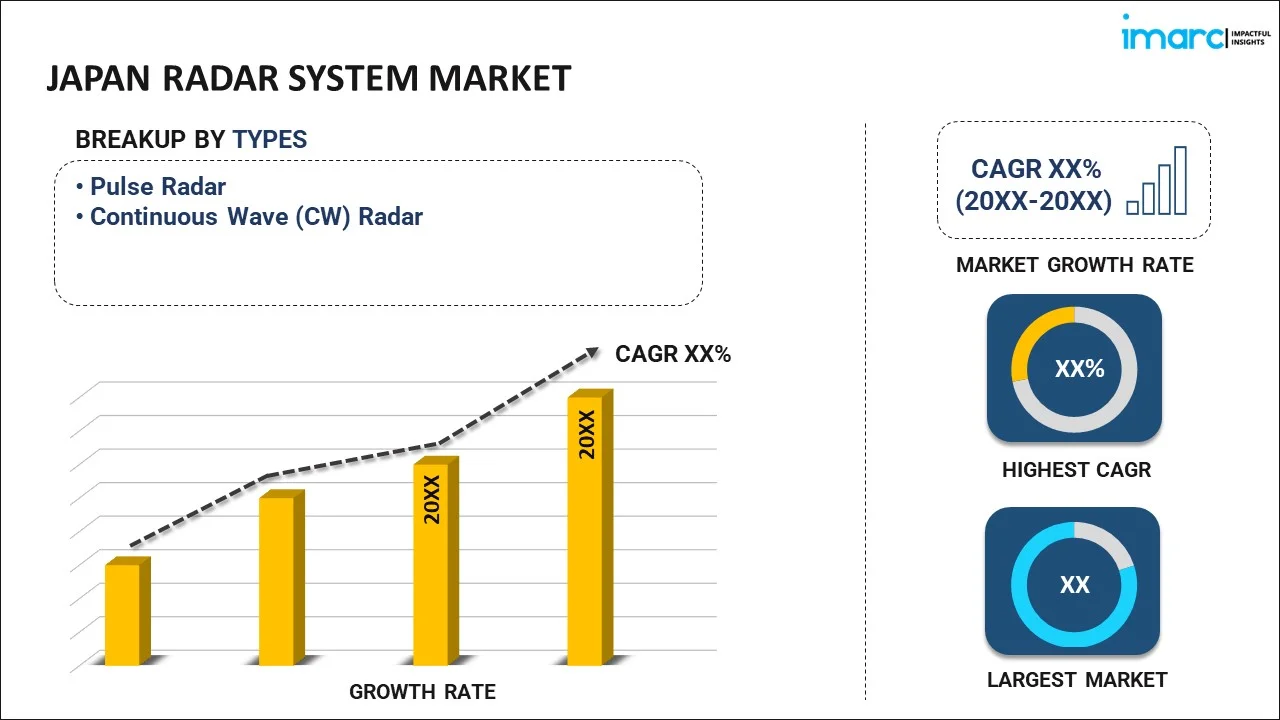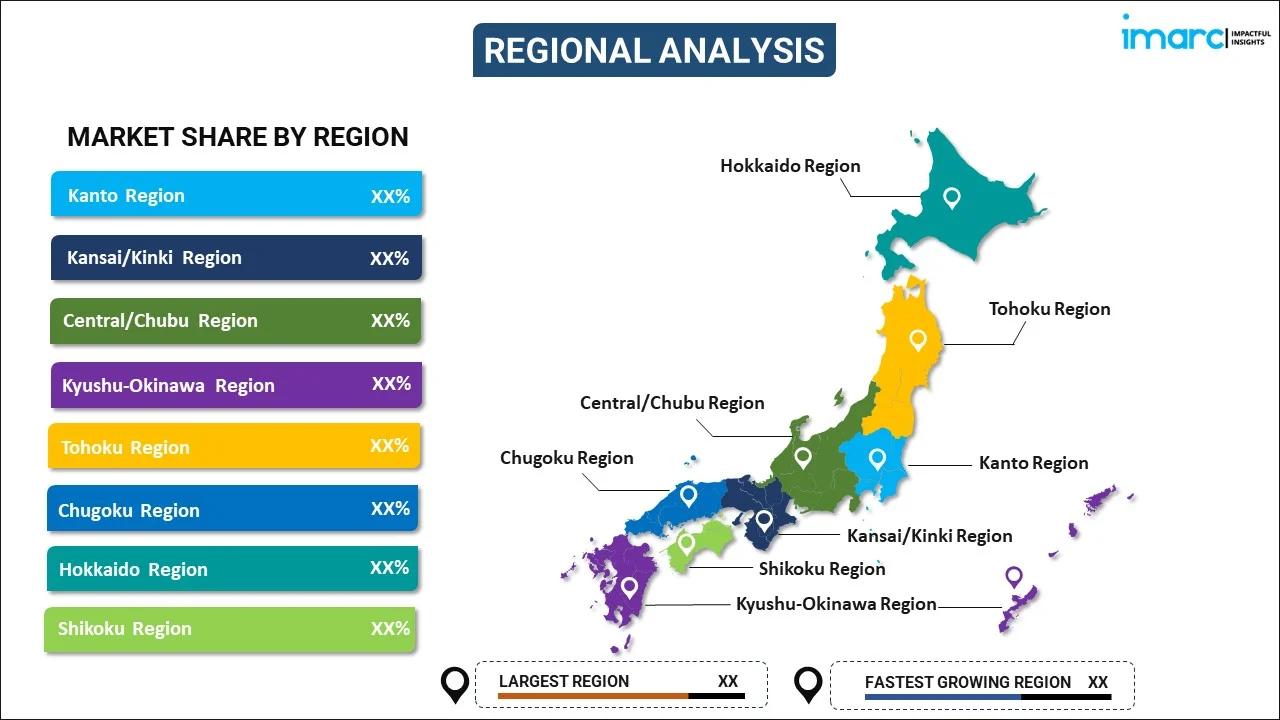
Japan Radar System Market Report by Type (Pulse Radar, Continuous Wave (CW) Radar), Component (Antenna, Transmitter, Receiver, and Others), Range (Short Range Radars, Medium Range Radars, Long Range Radars), Application (Air Traffic Control, Remote Sensing, Ground Traffic Control, Space Navigation and Control, and Others), Frequency Band (X Band, S Band, C Band, and Others), and Region 2025-2033
Market Overview:
Japan radar system market size reached USD 2,141 Million in 2024. Looking forward, IMARC Group expects the market to reach USD 3,421 Million by 2033, exhibiting a growth rate (CAGR) of 5.3% during 2025-2033. The rising investments by government bodies to upgrade the overall defense infrastructures are primarily driving the market growth.
|
Report Attribute
|
Key Statistics
|
|---|---|
|
Base Year
|
2024 |
|
Forecast Years
|
2025-2033
|
|
Historical Years
|
2019-2024
|
| Market Size in 2024 | USD 2,141 Million |
| Market Forecast in 2033 | USD 3,421 Million |
| Market Growth Rate (2025-2033) | 5.3% |
The radar system utilizes electromagnetic waves to identify, pinpoint, and monitor objects. Its components include a transmitter that emits radio waves, a receiver that captures the reflected waves, and a processor that assesses the data to establish the object's position and speed. Its applications span a wide range, encompassing air traffic control, military surveillance, weather prediction, and navigation. Notably, it operates effectively under various weather conditions and excels in detecting distant objects, making it especially valuable in identifying aircraft and ships. As a result, there has been a significant global surge in the demand for radar systems, owing to their numerous advantages. These advantages include heightened safety and security, enhanced operational efficiency, and improved situational awareness.
Japan Radar System Market Trends:
In the context of the Japanese market, several key factors are contributing to the growth of radar systems. One of the primary drivers is the increased investments by public and private agencies to modernize defense infrastructure are fueling demand for radar systems in Japan. Furthermore, heightened concerns regarding terrorist threats and geopolitical conflicts are fostering a positive market outlook for radar systems. These systems find extensive use in surveillance, reconnaissance, and weapon guidance, addressing security needs effectively. The increasing adoption of autonomous vehicles is also a noteworthy factor propelling demand for radar systems in Japan. These systems play a crucial role in autonomous vehicles by detecting obstacles and other vehicles, thereby preventing accidents and enhancing safety on the roads. Additionally, the growing volume of air traffic worldwide is driving demand for radar systems in the realm of air traffic control. Moreover, continuous technological advancements have led to the development of more sophisticated and efficient radar systems. Innovations such as digital signal processing, synthetic aperture radar, and phased array antennas have made radar systems in Japan more precise, accurate, and faster in their operations. This technological progress is projected to fuel the regional market over the forecasted period.
Japan Radar System Market Segmentation:
IMARC Group provides an analysis of the key trends in each segment of the market, along with forecasts at the country level for 2025-2033. Our report has categorized the market based on type, component, range, application, and frequency band.
Type Insights:

- Pulse Radar
- Continuous Wave (CW) Radar
The report has provided a detailed breakup and analysis of the market based on the type. This includes pulse radar and continuous wave (CW) radar.
Component Insights:
- Antenna
- Transmitter
- Receiver
- Others
A detailed breakup and analysis of the market based on the component have also been provided in the report. This includes antenna, transmitter, receiver, and others.
Range Insights:
- Short Range Radars
- Medium Range Radars
- Long Range Radars
The report has provided a detailed breakup and analysis of the market based on the range. This includes short range radars, medium range radars, and long range radars.
Application Insights:
- Air Traffic Control
- Remote Sensing
- Ground Traffic Control
- Space Navigation and Control
- Others
A detailed breakup and analysis of the market based on the application have also been provided in the report. This includes air traffic control, remote sensing, ground traffic control, space navigation and control, and others.
Frequency Band Insights:
- X Band
- S Band
- C Band
- Others
The report has provided a detailed breakup and analysis of the market based on frequency band. This includes X band, S band, C band, and others.
Regional Insights:

- Kanto Region
- Kansai/Kinki Region
- Central/ Chubu Region
- Kyushu-Okinawa Region
- Tohoku Region
- Chugoku Region
- Hokkaido Region
- Shikoku Region
The report has also provided a comprehensive analysis of all the major regional markets, which include Kanto Region, Kansai/Kinki Region, Central/ Chubu Region, Kyushu-Okinawa Region, Tohoku Region, Chugoku Region, Hokkaido Region, and Shikoku Region.
Competitive Landscape:
The market research report has also provided a comprehensive analysis of the competitive landscape. Competitive analysis such as market structure, key player positioning, top winning strategies, competitive dashboard, and company evaluation quadrant has been covered in the report. Also, detailed profiles of all major companies have been provided. Some of the key players include:
- Japan Radio Co. Ltd.
- Lockheed Martin Corporation
- Northrop Grumman Corporation
- Saab AB
- Tokyo Keiki Inc.
(Please note that this is only a partial list of the key players, and the complete list is provided in the report.)
Japan Radar System Market Report Coverage:
| Report Features | Details |
|---|---|
| Base Year of the Analysis | 2024 |
| Historical Period | 2019-2024 |
| Forecast Period | 2025-2033 |
| Units | Million USD |
| Scope of the Report | Exploration of Historical and Forecast Trends, Industry Catalysts and Challenges, Segment-Wise Historical and Predictive Market Assessment:
|
| Types Covered | Pulse Radar, Continuous Wave (CW) Radar |
| Components Covered | Antenna, Transmitter, Receiver, Others |
| Ranges Covered | Short Range Radars, Medium Range Radars, Long Range Radars |
| Applications Covered | Air Traffic Control, Remote Sensing, Ground Traffic Control, Space Navigation and Control, Others |
| Frequency Bands Covered | X Band, S Band, C Band, Others |
| Regions Covered | Kanto Region, Kansai/Kinki Region, Central/ Chubu Region, Kyushu-Okinawa Region, Tohoku Region, Chugoku Region, Hokkaido Region, Shikoku Region |
| Companies Covered | Japan Radio Co. Ltd., Lockheed Martin Corporation, Northrop Grumman Corporation, Saab AB, Tokyo Keiki Inc., etc. |
| Customization Scope | 10% Free Customization |
| Post-Sale Analyst Support | 10-12 Weeks |
| Delivery Format | PDF and Excel through Email (We can also provide the editable version of the report in PPT/Word format on special request) |
Key Questions Answered in This Report:
- How has the Japan radar system market performed so far and how will it perform in the coming years?
- What has been the impact of COVID-19 on the Japan radar system market?
- What is the breakup of the Japan radar system market on the basis of type?
- What is the breakup of the Japan radar system market on the basis of component?
- What is the breakup of the Japan radar system market on the basis of range?
- What is the breakup of the Japan radar system market on the basis of application?
- What is the breakup of the Japan radar system market on the basis of frequency band?
- What are the various stages in the value chain of the Japan radar system market?
- What are the key driving factors and challenges in the Japan radar system?
- What is the structure of the Japan radar system market and who are the key players?
- What is the degree of competition in the Japan radar system market?
Key Benefits for Stakeholders:
- IMARC’s industry report offers a comprehensive quantitative analysis of various market segments, historical and current market trends, market forecasts, and dynamics of the Japan radar system market from 2019-2033.
- The research report provides the latest information on the market drivers, challenges, and opportunities in the Japan radar system market.
- Porter's five forces analysis assist stakeholders in assessing the impact of new entrants, competitive rivalry, supplier power, buyer power, and the threat of substitution. It helps stakeholders to analyze the level of competition within the Japan radar system industry and its attractiveness.
- Competitive landscape allows stakeholders to understand their competitive environment and provides an insight into the current positions of key players in the market.
Need more help?
- Speak to our experienced analysts for insights on the current market scenarios.
- Include additional segments and countries to customize the report as per your requirement.
- Gain an unparalleled competitive advantage in your domain by understanding how to utilize the report and positively impacting your operations and revenue.
- For further assistance, please connect with our analysts.
 Inquire Before Buying
Inquire Before Buying
 Speak to an Analyst
Speak to an Analyst
 Request Brochure
Request Brochure
 Request Customization
Request Customization




.webp)




.webp)












